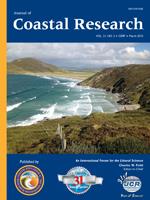Anderson, T.R.; Frazer, L.N., and Fletcher, C.H., 2015. Long-term shoreline change at Kailua, Hawaii, using regularized single transect.
Traditional long-term (decadal) and large-scale (hundreds of kilometers) shoreline change modeling techniques, known as single transect, or ST, often overfit the data because they calculate shoreline statistics at closely spaced intervals along the shore. To reduce overfitting, recent work has used spatial basis functions such as polynomials, B splines, and principal components. Here, we explore an alternative to such basis functions by using regularization to reduce the dimension of the ST model space. In our regularized-ST method, traditional ST is an end member of a continuous spectrum of models. We use an evidence information criterion (EIC = −2 times the log of the prior predictive distribution) to select the optimal value of the regularization parameter, instead of the usual L-curve method, because the EIC can also be used to evaluate basis function models yet does not require counting model parameters. To test the method, we apply it to historical shoreline data from Kailua, Hawaii, comparing the results with those from B splines (basis functions) and traditional ST. As expected, the regularized-ST and B-spline models both give shoreline change rates that vary more smoothly alongshore than the rates from ST. The regularized-ST model, along with the B-spline model, also shows significantly better predictive capability over the traditional ST model from a fivefold cross-validation. The regularized-ST model is more straightforward to implement than splines and may be attractive to users because of its continuous connection with the familiar ST method.





